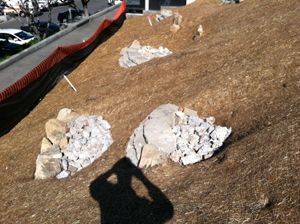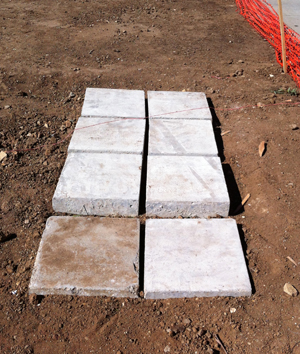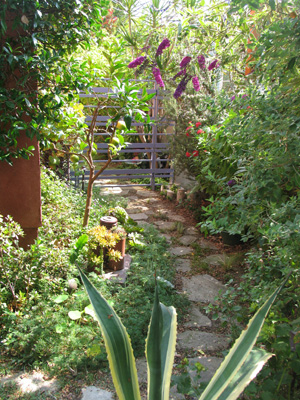Urbanite is another name for harvested old concrete; and G3 designers are pressed to include urbanite in all public projects so its acceptance as a beautiful recycled building material and permeable paving becomes universal. Urbanite is being used in both the Manhattan Beach Strand OFG and the Malibu Bluffs Park OFG in different ways.
The Manhattan Beach Strand Ocean Friendly demonstration garden uses plenty of it! The mini-infiltration basins are buffered by a short stack of partially mortared urbanite, and now the cobble filling the void space in the basins themselves has been filled with 4″ – 8″ urbanite cobbles. The walls and cobble will be stained with a soy-based concrete stain (Soycrete – “Mountain Desert” color) to complement the natural boulders harvested from a site up the coast in Malibu, CA.
In Malibu Bluffs Park Ocean Friendly demonstration garden, urbanite harvested from the original pads under picnic tables has been reused as pavers embedded in a decomposed granite walkway. The original plans called for pouring new concrete paver pads, but budgetary constraints and the desire to reuse materials already on site drove implementation of the alternative paving. The old concrete pads were fairly uniformly thick without rebar reinforcement, so they were easily cut into 18″ squares suitable for reuse.
The 18″ urbanite squares were reassembled in groups of 3 to 8 on compacted soil and sand bases to form 54” and 90″ long by 18″ or 36″ wide pavers in decomposed granite. The pavers will be stained with the Soycrete “Mountain Desert” to match the native Malibu boulders used in the dry creek bed and as accents throughout the landscape.
Pamela Berstler, Managing Member of G3, has been using urbanite in her designs since her practice began in the mid 1990’s, and she has pushed G3 Design Teams to consider the recycled material before importing stone or pouring new concrete.
After the Northridge Earthquake, urbanite was everywhere, Berstler explains. Los Angeleans piled it up on street corners and the cities arranged for it to be hauled away. At Flower to the People, my private design practice, we used to drive around in a 1984 Mazada hatch-back loading up the best pieces from the piles of rubble scattered around town. Our contractors would call our office and provide leads on a ‘stash’ they needed to be hauled away. By the early 2000’s, urbanite had caught on as a landscape building material, and suddenly it became more like buying something illicit. We’d spend days calling around to our colleagues asking ‘have you got any of the stuff or do you know where we can find it?’
At Flower to the People we used it as the go-to permeable paving. Laid in sand as broken pieces with groundcover planted in between the stones, it made a simple pathway; but when it was cut or chiseled and then planted, it became a much more sophisticated jigsaw pattern, suitable for the grand front entrance.
Urbanite is very easy to work with, and with the soy-based concrete stains available these days, there is no reason to import expensive stone alternatives if the recycled material is available nearby.






